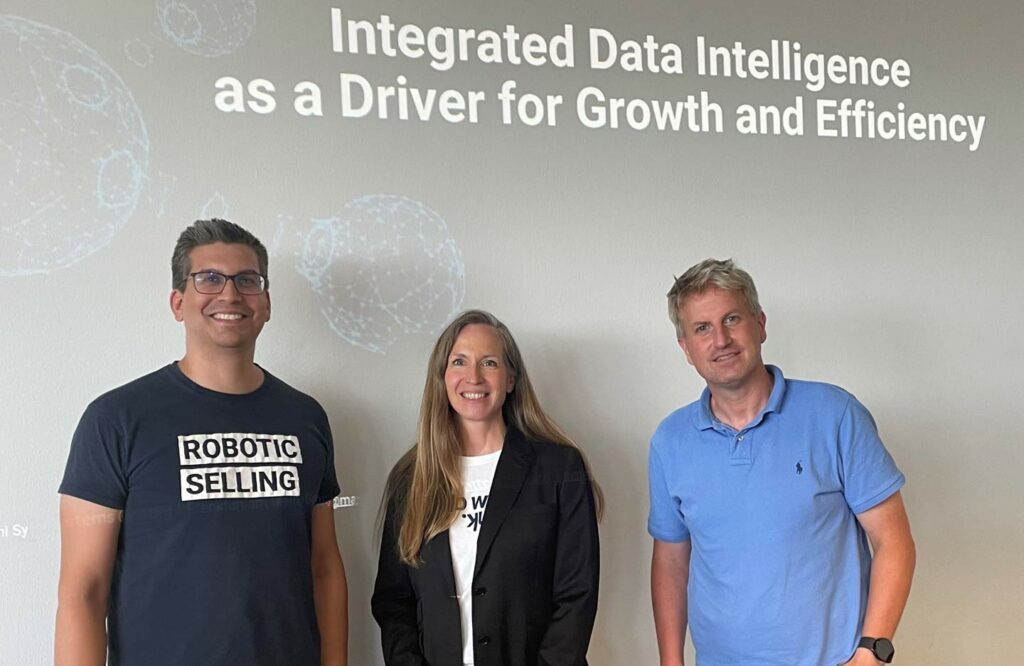Process optimization with Robotic Sales solutions – how an Enterprise Data Platform can optimally support the salesperson and how sales processes can be designed smartly across the boundaries of marketing and sales.
Digitization and automation are buzzwords that make some people think not only of new economic potential, but also of job losses. Corresponding reservations about digitization also exist in marketing and sales. However, the primary purpose of new and automated robotic sales solutions is not to make sales staff redundant. Rather, the decisive factor is that sales employees can work much more effectively and with greater focus than before thanks to consistent digital support. Making the right use of data in the company means leveraging previously untapped potential in the sales process. Sales increase because the information from the new, automated systems means that salespeople can always focus on the most promising leads and existing customers. Robotic Selling eliminates the need for salespeople to sit in front of a list of a thousand contacts and rack their brains over who to approach next. A powerful Robotic Sales solution manages the sales process and identifies the greatest current sales opportunities – but it does not visit the customers.
Data is still too often untapped - fields of action Robotic Selling
The trend toward digitization of the economy seems unstoppable. Across all industries, companies are accumulating ever greater volumes of data in a wide variety of systems, if only because of the online contact channels. But if you look at the reality in the marketing and sales departments of German companies, you see that digitization and automation have not yet made much progress here. For example, a representative study published by Bitkom in November 2017 found that while almost all companies are trying to reach their customers digitally, a good third of companies are doing nothing to better understand their customers’ wishes by analyzing user data.[1] The smaller the companies, the less they are exploiting the opportunities offered by digital analytics & optimization. Particularly worrying: only 53 percent of all companies say they derive any value from analytics and optimization. Yet the consistent use of available data would offer a great opportunity to decisively optimize and automate processes in marketing and sales. Although practically everyone is talking about what is possible, hardly anything has been implemented in most companies so far. Quite a few companies are not yet using their data because they don’t understand the meaning behind it, while those that have recognized the potential often don’t use the data because they are afraid of the complexity of the new processes. If a company really wants to drive its digitalization in marketing and sales and get serious about the idea of Robotic Sales Solutions, there are three fields of action to address:
- The integration of existing and new systems
- Automated process control
- Quantitative data analysis
Robotic Selling: Digitization begins with integration
The tiresome issue: the marketing automation system does not talk to the CRM solution that sales uses on a daily basis. Nor does the data from the ERP system, in which the order history of existing customers is stored, flow into the CRM. And what exactly is recorded in the PIM remains hidden from many employees in marketing and sales anyway. If digitization demands one thing from companies, it is this: an end of the silo culture. For consistent digitization and effective robotic selling, it is essential to synchronize the relevant data between the many systems in the company, usually bidirectionally and in real time. Provided these systems have an API or an alternative connection, it is also possible to synchronize the relevant data between the systems as required. In this way, any existing systems can be integrated with each other: from e-mail marketing, whether with Evalanche or Mautic, to the CRM system, whether this is SAP, Salesforce or Microsoft Dynamics. Only when a company gains a comprehensive overview – of truly all data from all sources available to it – does it create the basis for effective digitization and automation.
Design and automate the ideal processes
A key benefit of integration via APIs, for example, is that it also breathes a whole new life into legacy systems – by simply overcoming their limitations. Whereas up to now a company has usually had to operate within the narrow limits imposed by its existing systems when designing its processes in marketing and sales, integration ensures that a company can think of its processes in a completely new way. This and the use of external services make it possible, in principle, to actually implement any desired process that is formulated in a specification language such as BPMN (Business Process Model and Notation). These new automated processes can affect the process of acquiring new customers in an online-based lead management workflow: from lead generation to lead nurturing to handing over the promising sales-qualified lead to sales. However, it can be just as valuable for a company to refine its existing customers or existing contacts, calculate sales probabilities and automatically create relevant opportunities for sales. Automatic activation of nurture campaigns for existing customers with high cross-selling and upselling potential is also conceivable. In many cases, it makes sense to closely integrate the new robotic sales solutions with traditional sales processes.
Robotic Selling enables creativity on a white page
For companies, the typical knockout criteria for a new, innovative process journey are usually at technical level. However, powerful integration of the various IT systems ensures that marketing and sales managers can finally break free of all shackles when designing their ideal processes – there are no longer any limits to creativity. Anyone, who wants to, can literally start on a blank sheet of paper by simply recording their ideal process. Within the framework of Robotic Sales Solutions, the processes then can be made dance, so to speak, across all phases of the marketing and sales processes: from lead generation to nurturing to sales. It is irrelevant which specific systems are ultimately connected to each other. Whether these are open source solutions such as SugarCRM and Mautic or other cloud-based systems for sales and marketing automation – a company decides which systems it wants to use entirely according to its needs. This is because the integration allows the required functions to be provided simply as services. Even if the new, automated process is completely redesigned – at the end of the day, for example, the salesperson simply continues to work in his familiar Salesforce environment, if desired.
Scientific decision models
An ambitious and realistic goal of Robotic Selling is to ensure that the next contact takes place between the sales representative and the most promising customer. Bringing together and integrating all relevant data is an essential component for this. The second central element is the ability to model processes freely and to use the appropriate systems and external services for this purpose. A third essential aspect is the area of data science. Science has made enormous progress in recent years when it comes to turning data into insights. Modern methods of data analysis and scoring – from pattern recognition to machine learning – now make it possible to determine purchase probabilities with a high degree of reliability. In addition to all the data already available in the company, external data can and should also be incorporated in the process. Often, for example, microgeographic data offered by market researchers such as GfK is relevant – this includes residential environment information such as social, age and business structure or purchasing power. When building automated processes, you often get to the point where decisions have to be made in the process. Perhaps a company, having acquired a new customer, wants to automatically initiate a cross-selling process after two months. In such a case, quantitative data analysis will help create a decision model. The complex mathematical formulas that are the result of the quantitative analysis will ultimately provide the answer to the question of which other product the new customer should be addressed with in this cross-selling process. The scientific analysis of all the data – including external data – available on customers and their behavior makes it possible to automatically determine the products with the highest probability of closure for each new customer.
From closing probability to churn scores in Robotic Selling
The result of good data analytics and scientific decision models can also be that the regional sales representative’s system displays the purchase probability for each of the ten products from the company’s portfolio for each lead or customer from his region. In other words, he can always make the next call to the customer with the highest probability of closing a deal for a particular product. Or the system can show the sales employee only those opportunities whose score has exceeded a defined threshold. In any case, data analytics provides the intelligence for robotic selling – and makes it the ideal control instrument for sales. In addition, the scientifically based data analysis also provides important insights into topics such as customer value analysis, customer segmentation, and churn prevention, if necessary.
Empowering salespeople and overcoming silo structures with Robotic Selling
In many cases, after the introduction of Robotic Sales Solutions and after the optimization of the marketing and sales processes, there will not be such a big change from the sales employee’s point of view. Sometimes only the selection of contacts with which the sales employee works is optimized afterwards. Dozens of real-world examples already show the positive impact of modern Robotic Selling on marketing and sales. These companies have overcome old silo structures, they use all relevant data about their customers, evaluate them through scientific data analytics and at the same time create ideal processes in lead marketing and sales, free of technological limitations. Robotic Selling leverages previously untapped potential. It does not make human salespeople obsolete – in contrast it makes them more successful.



